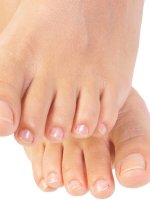
|
Fungal Guide
.ca
Fungal Infections Treatment Information.
|

|
| Fungal Guide | About Us | Dermatology Glossary | Skin Care Network | Fungal Guide Site Map |

Do You Have Strange Looking Nails?
How to avoid nail fungus and treat it.
Nail fungus, or "onychomycosis"is an uncomfortable and unattractive condition that affects millions of people across North America. The bad news is it can be contagious, but the good news is that it is treatable. Learn more about treatments on www.fungalguide.ca/treatments/antifungal_drugs.html
Nail fungus can occur in anybody. Local defects in the nail or sweaty conditions as well as people with reduced immune systems can trigger it. Having a nail fungus does not mean that you have an immune problem but is more common in those that have.
There are a number of signs that you've acquire a nail fungal infection. Best to check with your doctor for a diagnosis to be sure, but the usual symptoms of a nail fungal infection are:
- nail discoloration,
- changes in nail texture and growth and
- nails that become crumbly, break easily, and
- nails that grow irregularly
Why did I get nail fungus?
Nail fungus can appear more often if you have a weak immune system, but there is currently no option to boost your immune system to keep fungal infections at bay. You are also at a greater risk for nail fungus if you are over the age of 40 and have:
- Diabetes
- Long-term, untreated athlete's foot
- Previous nail fungus infection
- Circulatory problems
- Organ or bone marrow transplant
- Long-term corticosteroid therapy
It will take some time before your nails will completely heal. Depending on your infection, it could take six months or longer before your fingernails grow out, and up to a year for toenails.
Treating nail fungus
A fungal nail infection is diagnosed from a sample of the debris under the nail. Toenails are nearly seven times more likely to be infected than fingernails because of the warm, moist environment of wearing socks and shoes.
Remember that, although it might take some time, leaving your nail untreated means that it can get worse, spread to your other nails and also, but rarely, spread to other members of your household.
Treatment Options:
- Nail fungus is a progressive and recurring condition (at least one in five patients, or 20 per cent, will have a recurrence of the original nail infection at some time) making re-treatment with medication necessary.
- Can be difficult to eliminate as it grows slowly.
- Anti-fungal brush-on treatments like Penlac™ and oral medications are available to relieve symptoms, although oral medicine can present side effects to the liver, skin and/or bone marrow. (Read more on www.fungalguide.ca/treatments/ciclopirox.html)
- Surgical treatment and nail debridement (removing debris and filing down thickened sections of the diseased nail) is another option.
- Even if successfully treated, nail fungus often comes back. If left untreated, not only is it unsightly and embarrassing, but it can be very painful.
- Doctors usually recommend treating fungal nail infections when secondary problems arise such as: pain, recurring ingrown toenails, or secondary bacterial infections of the nails or skin. (Read about bacterial infections at http://www.skincareguide.ca/conditions/bacterial_infections.html )
- Help prevent recurrence by using an antifungal product in your shoes and runners, or consider throwing them away.
Preventing nail fungus
- Avoid nail polish and plastic or acrylic nails, which can trap moisture along with fungi.
- Keep your nails cut straight across.
- Ensure feet are dry and well ventilated.
- Eat a balanced diet with protein to promote healthy growth
- Check with your manicurist if instruments are regularly sterilized
- See you doctor at the first sign of any suspicious symptom
For more information, click on www.FungalGuide.ca
Back to Fungal Infections Articles Index